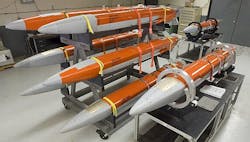Air Force asks Raytheon to build 250 air-launched EW jamming drones to defeat enemy missile defenses
EGLIN AIR FORCE BASE, Fla., 23 March 2015. U.S. Air Force airborne weapons experts are asking Raytheon Co. to build 250 electronic warfare (EW) jamming drones under terms of a $91.6 million contract announced last week.
Officials of the Air Force Life Cycle Management Center at Eglin Air Force Base, Fla., are asking the Raytheon Missile Systems segment in Tucson, Ariz., to provide 250 Miniature Air Launched Decoy Jammers (MALD-J), which are relatively simple air-launched unmanned aerial vehicles (UAVs) designed to jam enemy radar.
The contract involves lot 8 of the MALD-J missile program. MALD-J is an electronic jamming version of the Raytheon Miniature Air Launched Decoy drone that navigates and operates much closer than conventional EW to the victim radar, Raytheon officials say.
The MALD-J EW drone can loiter in the target area for an extended time to help keep manned aircraft out of harm's way. The MALD-J low-cost, air-launched programmable unmanned aircraft that duplicates the combat flight profiles and signatures of U.S. and allied aircraft.
By duplicating the radar signatures of manned aircraft the MALD-J can spoof enemy radar and tempt ground-to-air missiles to shoot at the wrong targets. These systems attempt to force enemy missile batteries to run out of missiles to clear the way for manned attack aircraft.
MALD is an expendable air-launched flight vehicle that looks like a U.S. or allied aircraft to enemy integrated air defense systems (IADS). The U.S. and its allies use MALD and its jamming companion MALD-J to confuse and deceive enemy IADS by sending a formation of MALDs into hostile airspace.
MALD weighs less than 300 pounds and has a range of approximately 500 nautical miles. After it is launched from its host aircraft, MALD flies a preprogrammed mission.
In addition to protecting valuable aircraft, MALD offers counter air operations to neutralize air defense systems that pose a threat to U.S. and allied pilots.
Major suppliers to the MALD system include AML Communications in Camarillo, Calif.; AUSCO in Port Washington, N.Y.; BAE Systems in Berthoud, Colo.; CEI in Sacramento, Calif.; Celestica in Austin, Texas; Eagle Pitcher in Joplin, Mo.; EDO in Bohemia, N.Y.; Enser in Pinellas Park, Fla.; Engineered Fabrics Corp. in Rockmart, Ga.; GDOTS in Redmond, Wash.; Hamilton-Sundstrand in Rockford, Ill. and San Diego; LaBarge in Joplin, Mo.; Moog in East Aurora, N.Y.; and Tecom in Westlake Village, Calif.
For more information contact Raytheon Missile Systems online at www.raytheon.com.

